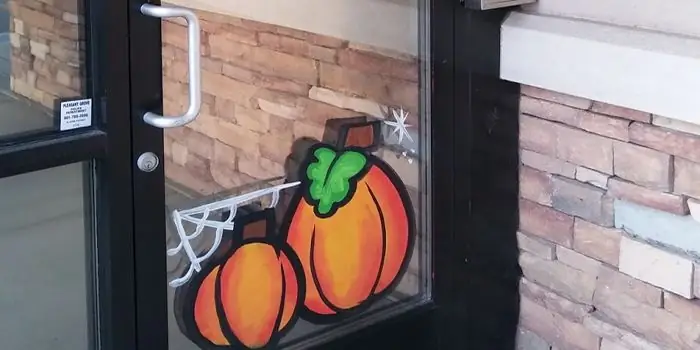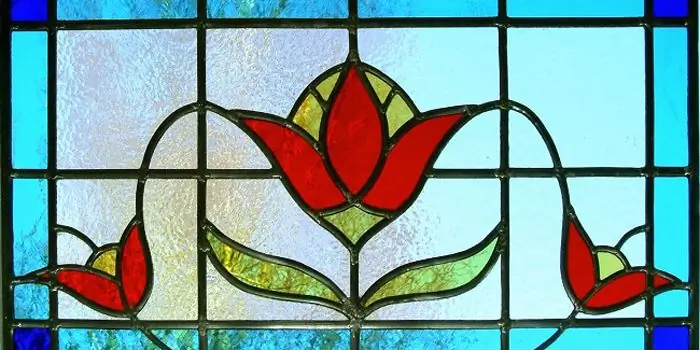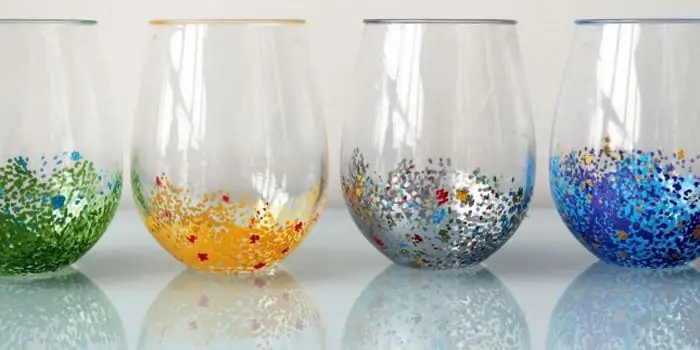Painting glass replaces some people with a change of interior. Literally all household items made of glass are subject to painting: door and window stained-glass windows, cups, plates, glasses, lamps, chandeliers, countertops and other household utensils.

Paints suitable for staining glass
There are three main types of paints suitable for painting glass.
Polyurethane. They dry quickly and give the picture a glossy sheen. Moreover, a glass object painted with polyurethane paint remains transparent
Glyphthalic. Some craftsmen prefer to use glyptal paints. Their advantage is the ability to achieve a variety of colors and shades. Lack of glyptal paints in long drying
Acrylic paints are also used for painting glass. On the glass surface, they lay down in a dense layer and give it a haze. Sometimes artists mix different shades of acrylics to achieve depth or richness of color
Dot painting
Dot painting on glass (another nameof this style - point-to-point) originated in India about five millennia ago. A craftsman who has mastered this style will be able to draw quite complex patterns.

This type of painting on glass, although easy to perform, requires the artist to have at least basic knowledge of fine arts.
An artist who masters the art of spot painting on glass uses three types of paints:
solvent based paints;
paints based on synthetic resins;
acrylic
The cheapest option is a solvent-based dye. It also poses the greatest danger to human he alth. The benzenes contained in it evaporate during work and, mixed with air molecules, enter the artist's respiratory system.
Synthetic paints are not that harmful, but they are unsuitable for painting outdoor objects outside the living space.
Experts call painting glass and other glass products with acrylic paints a true pleasure. The high cost of this product more than pays off due to clear advantages: fast drying (maximum 20 minutes), environmental friendliness, immunity to environmental manifestations and a long shelf life (from 10 to 30 years).
Consumables needed for spot painting
In addition to paints, the artist will need rags and a jar of alcohol (for degreasing the surface on whicha drawing will be applied), brushes (wide and narrow), a palette (if the paint is packaged in jars, a palette is not needed) and a cup of water. Water is diluted with paints squeezed onto a palette from tubes.
How to make DIY paint
It is not necessary for a non-professional artist to buy ready-made paints in a store. A person for whom glass painting is a hobby can afford a budget, but quite high-quality alternative.

To prepare paint for stained-glass windows, chandeliers and glazed terraces, 5 grams of gelatin is dissolved in 100 grams of water heated to a temperature of 50-80 degrees. Multi-colored ink is also added here. The resulting mixture is still warm, applied to skimmed glass, after giving the latter a horizontal position.
For lack of the right paints, you can "revive" a dry felt-tip pen by soaking its core with a few drops of water mixed with vinegar. The dye obtained in this way has its own characteristics: it is afraid of temperature changes (dries only at room temperature) and dampness (surfaces painted with such dyes must be coated with waterproof varnish).
Craftsmen advise
To get rich black paint, you need 20 grams of charcoal, a little black printing ink and 60 grams of silicate glue. All components are mixed in a glass container, after which the resulting mixture is set aside for a while to cool completely.
If it becomes necessary to get a white matte color, silicate gluecombined with white clay (kaolin) in a ratio of 4:1.
When making homemade paint, the craftsman must be especially careful when mixing the ingredients. The texture of the future paint and how it will lie on the glass surface depends on this.
How to paint glass? How to apply paint correctly?
To paint glass in different colors, you will need diluted gelatin and dyes for fabrics (also pre-diluted with water). These components are slowly mixed together until the desired shade is formed.
Oxides of chromium, copper, antimony, manganese, cob alt and gold can also act as dyes.
Now let's talk about how to apply paint.
Before you start painting the glass, it should be thoroughly washed with a specialized detergent and rinsed first with hot and then cold water.

Paints may only be applied after the surface to be painted is completely dry and degreased with acetone or other alcohol products.
The more carefully the glass surface is prepared for work, the better the coloring substance will lay down and set. Immediately before starting work, a masking tape is applied to a clean and dry surface (where painting is not provided). Masking tape (or masking tape) must be removed immediately after the painted surface has dried.
Applying colorful patterns is done with a flat brush (flute), a hard brush (made frombristles and is used for coloring the ends), spray gun, foam swabs, paint roller and tape.
If a vertical surface is to be painted, paint is applied in small strokes from top to bottom with a dry flat brush. Do not allow smears to overlap one another. This technique is used for painting on double-glazed windows, interior doors and bottles.
Tools for painting bottle glass. How to paint?

To do this job you will need the following tools:
nail polish remover and cotton pad (to degrease the surface);
white primer and foam pad;
brushes and pencil;
carbon paper (carbon paper);
acrylic paints, texture paste
A carefully washed and dried glass bottle is degreased using nail polish remover and a cotton pad for this purpose.
At the next stage of preparation, you will need a foam sponge and white primer. The primer is applied in two layers, and each of the layers must dry well. Only after that, the craftsman will be able to move on to the next operation.
Even a person who has never learned to draw can cope with painting bottles with acrylic paints. It is enough to find a suitable picture on the pages of magazines or on the Web.
A sheet of paper with a printed pattern is shifted with a carbon paper and fixed on the bottle. Now the amateur artist will need a sharpened pencil. With it, the main contours of the picture will be translatedon the surface of the bottle.
Volumetric parts are applied to the glass surface using texture paste, and flat parts are applied using acrylic paints.
When the work is completed and the paints dry, the artist will only have to arm himself with a thin brush and draw the contours of individual details.






